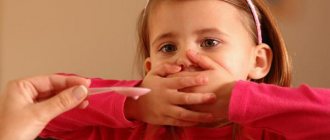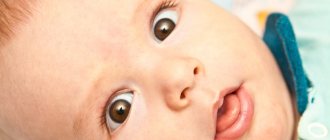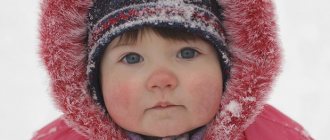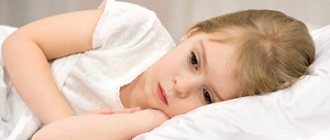What to do if your child has sleep disorders?
advises a pediatrician in a medical clinic.
How to make sure that the child sleeps well and allows parents to get enough sleep is a pressing issue that concerns almost all parents. Indeed, sleep disturbances in a child can not only be signs of health problems, but also themselves cause health problems in parents.
One of the most rewarding moments for parents is to look at their newborn baby sleeping peacefully. The value of sleep can be measured by the energy of happiness that a child gives to his parents during the day. Sleep is a vital part of the growth and development of a baby's body and mind. Behavioral or developmental problems may occur when a child does not sleep well. A child's sleep problems, night awakenings and endless "putting" of a child can turn the whole family's life into a nightmare full of sleepless nights and the unwanted effects of stress.
Parents must, on the one hand, physically provide the child with the opportunity to sleep normally, on the other hand, psychologically instill in the child the ability to fall asleep and maintain healthy sleep, which the child will carry throughout his life.
In this article we will look at sleep disorders in children that are not the result of other diseases or disorders, but are caused only by age-related and behavioral reasons.
TYPES AND REASONS
There are several explanations for why a child holds his breath during sleep. The characteristics of the pathology depend on its type.
Central apnea
Diagnosed in 60% of premature babies born at 35 weeks or earlier weighing 2.5 kg or less. Pathology appears as a result of dysfunctions of the respiratory center. Located in the lower part of the brain. This center does not control the breathing muscles in children with sleep apnea. This is why a child often holds his breath for a long time during sleep at night.
Reasons for development:
- Immature nervous system of the baby;
- Hypoglycemic syndrome (low blood glucose concentration);
- Impaired pulmonary gas exchange;
- Seizures in epilepsy;
- Diseases caused by bacteria and viruses;
- Anemia;
- Smoking during pregnancy.
Interestingly, with central apnea, breathing consists only of exhalation, and inhalation seems to be lost. For this reason, a child’s breathing stops during sleep for quite a long time.
Obstructive apnea
With the obstructive type of deviation, the child breathes poorly during sleep due to narrowing of the airways. The baby sobs sharply when inhaling and often wakes up from this (several times a night). The disease often develops due to anatomical problems:
- Macroglossia. This is the name for congenital pathology of the tongue, when the organ of speech is enlarged to critical sizes.
- “Cleft lip.”
- Achondroplasia is an abnormality in the development of the bones of the skull.
- Laryngeal muscle dysfunction.
- Enlarged tonsils, tonsils
- Stridor (from Latin “hissing”) is an excessively narrow larynx.
- Obesity.
Obstructive apnea can make itself felt at any age. Most often, preschoolers - children from 2 to 7 years old - suffer from its manifestations.
Mixed
The term “mixed apnea” indicates a mixture of signs of the central and obstructive type of pathology. At the same time, the central type appears at the very beginning, gradually developing into airway obstruction. This type is rare and difficult to diagnose.
Mixed apnea is often observed as a consequence of a number of problems:
- impaired body thermoregulation;
- obesity;
- disturbed sodium-calcium balance.
Intermittent breathing during sleep with a mixed version of the disease is often observed in newborns who frequently regurgitate.
How much and how should a child sleep?
A child's need for sleep is very different from that of an adult. But did you know that by six months, a baby can already sleep at least nine hours a night? This may sound like a miracle to some parents because most children's sleep patterns are different. But most children have the ability to sleep through the night. If, of course, their parents can teach them to do this. Sleep problems in children are very common. But most of them can be quickly corrected once parents identify them and learn what to do from the literature, from a child sleep specialist, or after consulting with a pediatrician.
WHAT IS APNEA IN CHILDREN
With sleep apnea, a child stops breathing during sleep.
Such delays can range from 15 seconds to several minutes. The problem is that pauses occur involuntarily and at the moment of sleep, when the sleeper has practically no control over the state of his body. Many people believe that apnea is a synonym for the word “snoring.” However, snoring is only one manifestation of apnea. Although both of these conditions can occur in one person.
On a note! Often, interrupted breathing in a child's sleep is observed if the baby was born prematurely (option: with Down syndrome or cerebral palsy).
Doctors characterize the disease as a syndrome. In other words, this pathology is accompanied by anatomical disorders or various diseases (cardiovascular, endocrine or nervous systems, brain, etc.). Such diseases can be either congenital or acquired.
A 2-year-old child can hold his breath during sleep from 10 to 90 times.
https://skystream.org/o-detyah/rebenok-zaderzhivaet-dyhanie-vo-sne/
Has your child really begun to sleep poorly?
Here are some signs you can use to determine if your child has trouble sleeping:
- Parents spend too much time helping their baby fall asleep.
- The baby wakes up more times during the night than he eats.
- A child's daytime behavior and mood are significantly affected by poor sleep.
- Parents do not get enough sleep because the child does not sleep well at night.
- A child's poor sleep affects his relationship with his parents.
- The child constantly tosses and turns during sleep.
What to do when your child wakes up from a nightmare
According to statistics, about 85% of all children have experienced a nightmare at least once between the ages of 3-7 years.
Approximately 50% of children experience nightmares more or less regularly. Moreover, these days this figure is steadily growing. Psychologists partly explain this phenomenon by the fact that in the modern world, both adults and children have too much “communication” with inanimate sources of information (TVs, tablets, smartphones, etc.). Due to the impossibility of adequate participation in observed situations, the child accumulates special stressful experiences during the day, which makes itself felt, turning into childhood fears and nightmares.
Unlike childhood fears, nightmares are extremely rare in young children. As a rule, the “target audience” of nightmares among children is children 5-7-11 years old.
What to do if your child has trouble sleeping?
There are no general rules for children's sleep, because living conditions can vary greatly from family to family, just as children themselves differ significantly from each other. One child may sleep well only alone, another may sleep well only in the same bed as his parents, and a third will sleep well even in a room where older siblings play.
Getting ready for bed can be a scary time for many young children. They are afraid to be alone, afraid to leave their parents, closing their eyes and falling asleep. It may also be difficult for parents to part with their child during sleep, which leads to the desire to put him next to him. Until now, despite the advent of baby monitors, mothers get up every night to check if my child is breathing.
The key to solving sleep problems is to create a consistent bedtime routine that will help your child fall asleep quickly and get a good night's sleep. This scheme also needs to be transferred to daytime sleep. Putting your baby to bed can be difficult at first, but repeating the same ritual will soon pay off.
“evening ritual” to prepare for bed
- Plan a routine before bed that starts around the same time every night.
- Change your child's clothes, wash him, brush his teeth and prepare his bed.
- Then set aside 10 to 30 minutes for special quiet time with your child: watch a picture book, listen to calm music. Try not to use luminous gadgets: the blue spectrum of light from LED screens has a negative effect on the retina of the eyes.
- During the “before bedtime” activity should not be very active, there is no need to run, jump, or wrestle with the child. It is best to read or tell a good story, avoiding scary stories. A good bedtime ritual will make for a relaxing, calm, and quiet evening.
Still have questions?
Get an online consultation from leading pediatricians in St. Petersburg!
A professional and experienced pediatrician will answer your questions.
Medical care for a child without leaving home at a convenient time.
sign up for a consultation
A Skype consultation lasts 45 minutes.
Why do you sleep on the go?
No one likes to feel like a “sleepy fly,” because every person wants to be active and work productively. To fix the problem, you need to answer the question: “Why do I sleep on the go?” The reasons may be as follows:
- Breathing disturbances during sleep. If a person is out of breath or snoring, they will wake up feeling tired and groggy.
- Uncomfortable conditions (uncomfortable bed, stale air in the room, incorrect air temperature in the room). As a result, a person does not get proper rest.
- Taking sleeping pills often leads to drowsiness, since the effect of most of them lasts more than 6 hours. Thus, the human body is awake, but the brain still continues to sleep.
- Chronic fatigue associated with low hemoglobin levels, hypovitaminosis and oxygen starvation.
- A sedentary lifestyle is accompanied by the accumulation of lactic acid in the muscles, which causes a sleepy state.

Basic rules for good sleep
- Establish a consistent sleep routine and stick to it.
- Set a consistent time for waking up in the morning.
- Create a calm and relaxing environment in your child's bedroom.
- Talk to your child before bed. Don't let the TV, gadgets or computer take over your space.
- Do not allow children to watch anything that is not appropriate for their age, day or night. Control information that might frighten them.
- Don't let your baby fall asleep while being held, rocked, bottle-fed, or breastfed.
- Do not allow your child to eat caffeinated foods or drinks before bed, including chocolate or soda. Try not to give him stimulant medications before bed.
Sleep problems in infants
A breastfed baby can disrupt the entire family's sleep, causing distress in parents who are willing to do anything to get the baby to sleep. Someone rocks a child in a stroller or cradle, someone rolls a child in a car around the block - just so that he will finally shut up and fall asleep.
Well, the parents’ state of mind can be understood, but you shouldn’t support behavior that solves immediate problems, but will cause much larger troubles in the future. This behavior creates disrupted sleep patterns in the child that will only work under certain conditions because the child learns to associate falling asleep with a certain person or with a certain activity. The same problems can occur in adulthood (it is possible that they originated in childhood). For example, falling asleep may require a certain position or a special “sleepy” pillow. If there is no such pillow (for example, while visiting or in a hotel), then a person may toss and turn and not fall asleep for a long time, because the mechanism for falling asleep is associated with certain conditions.
The baby behaves in the same way, who cannot fall asleep without his “sleeping pillow”, which can be the mother herself, the need to rock the child, breastfeed, or hold him in her arms. If these conditions are absent, the child does not fall asleep because he has learned to associate sleep induction with certain people, actions or objects. This problem is called pathological sleep association disorder.
TREATMENT OF THE DISEASE
The causes of sleep apnea in a child may vary depending on the age of the child.
Accordingly, the treatment of nocturnal disorders should also be selected taking into account the age characteristics of children with problems with breath holding during sleep.
In newborns
Premature babies are placed in pressure chambers. Here, doctors constantly monitor the breathing of newborns and provide assistance in emergency situations.
The initial phase of treatment is the use of tactile stimulation. The doctor taps and slaps the baby's body, activating his breathing.
If the attacks are prolonged and repeated frequently, pulmonary stimulation is used on the newborn.
When the attacks are reduced and no complications are observed, the child is discharged. Doctor's supervision continues at home.
In preschoolers
When a child from 2 to 5-6 years old holds his breath during sleep often and for a long time, CPAP therapy is applied to him.
The procedure helps support the walls of the airways by accumulating air under high pressure.
Before going to bed, a mask is placed on the little patient’s face with a hose running from it to supply air. The process is controlled by a doctor. CPAP therapy can last for months or even years.
When the disease is complicated by additional pathologies, doctors recommend surgical correction of the problem. In such cases, the following types of operations are relevant:
- correction of the uvula;
- removal of adenoids;
- correction of the shape of the nasal septum;
- elimination of respiratory tract pathologies.
Operations are effective in 80-100% of cases. The next check of the little patient is carried out after 1-2 months.
In school-age children
If sleep apnea occurs suddenly in adolescents, it should be seen by a doctor to determine the cause of the respiratory system disorder.
After diagnosis, the same treatment methods are used for schoolchildren as for preschoolers: drug or CPAP therapy, surgical intervention.
Waking up at night - is this normal? Yes!
It is completely normal for both adults and children to wake up several times during the night. This occurs most often during the deep stage of sleep. Adults, as a rule, are unaware of such awakening and quickly return to sleep. But young children react differently to waking up. They may feel insecure, even scared, when they wake up in the dark in the middle of the night. As a result, they cry, scream, and do whatever they can to get someone's attention. The natural response of parents in this case is to console the child to help him fall asleep again and give himself a few more hours of sleep. Most often, parents help their baby fall asleep by feeding him, rocking him to sleep, holding him in his arms, or lying next to him.
As in the case of falling asleep, in these cases, for night awakenings, a conditioned reflex connection is also formed between the parents, their certain actions and falling asleep. As a result, children cannot fall asleep on their own if they wake up during the night. And they will wake up at night all their lives.
The solution to the situation is for parents to overcome their natural desire to comfort the child and teach him to fall asleep on his own.
SYMPTOMS AND SIGNS
If a child holds his breath for a few seconds during sleep, this does not indicate apnea.
You can suspect a symptom if the baby:
- often “forgets” to breathe in his sleep - 10-15 times per hour;
- snores, coughs and grunts in his sleep;
- often tosses and turns, sleeps with his neck stretched out;
- the child breathes unevenly in his sleep, his breathing is intermittent;
- suffers from enuresis;
- breathes through the mouth during the day: this is how a small organism tries to compensate for oxygen starvation;
- The sleeping person's chest remains practically motionless when inhaling.
Apnea should not be confused with periodic holding of a child’s breath during sleep when:
- The periodic delay interval usually does not last longer than 10 seconds.
- The sleeper is able to control inhalation and exhalation independently.
Most often, a baby before and after a year, as well as a child 3-6 years old, holds his breath in his sleep.
The disease is dangerous because it does not manifest itself in any way during wakefulness - children breathe normally. The pathology continues to progress.
Advice! In the first months after the baby is born, parents should carefully listen to the baby’s night breathing during sleep.
Parents should definitely notify their pediatrician if they suspect sleep apnea in their child.
How to teach a baby to fall asleep without parental help?
Parents should know that the child can actually fall asleep on his own once he is given the opportunity to do so. This does not mean that mom or dad should ignore the baby's cries and cries. Parents should always make sure their child is safe. Parents need to know if he is crying because he is hungry, sick or his diaper is dirty.
Young children often experience pain when teething, having a cold or ear inflammation. They may often wake up from pain. In these cases, parents, of course, will have to get up and calm the kids. Newborns will require a lot of attention during the night: frequent feedings (sometimes every 1.5-2 hours) and changing diapers. But when the baby is six months old, he will be able to sleep all night long without waking up.
To solve a child's sleep problem, parents need to teach him to fall asleep with a new set of associations: conditioned reflex connections between objects, events and sleep induction. The child must learn to use these new connections throughout his sleep time, night and day. It is best to start teaching a child at night.
Diagnosis of narcolepsy
In the early stages, narcolepsy is diagnosed by visible symptoms. But it is worth noting that just in the early stages, the patient may not pay attention to the signals that the body gives, attributing his condition to a large amount of work, a passive lifestyle, or the inability to fully rest. Therefore, I don’t even think about going to the doctor. Anxiety appears after prolonged insomnia, nightmares and hallucinations.
Since the problems are related to the nervous system, you need to contact a neurologist. Professional diagnosis is carried out in a somnology laboratory by testing the patient, as well as by physical methods (inspection, percussion, auscultation and palpation).
Correct diagnosis is very important to avoid mistaking another neurological disease for narcolepsy. In the case of diseases of the nervous system, the treatment approach must be very subtle and precise, so effective treatment directly depends on accurate diagnosis.
There are two main tests used in diagnosing narcolepsy:
- Polysomnography.
- MSLT
The polysomnogram test is as follows. The patient is in a room and electrodes are attached to his body.
They record parameters such as:
- heartbeat;
- muscle activity;
- wave activity inside the brain;
- eye activity and the like.
MSLT stands for Multiple Sleep Latency Test. MSLT testing is carried out immediately after polysomnography, the next day. The essence of this study is to confirm the presence of drowsiness and record the onset and duration of sleep. It is carried out in several stages: the patient should fall asleep approximately every 3 hours. Sleep duration is about 20 minutes; in this case, on the patient’s body, just as in the first test, there are electrodes that record brain activity.
The complex of results obtained from two tests allows the doctor to understand whether the patient’s condition corresponds to narcolepsy. Based on the interpretation of the results, appropriate treatment is prescribed.









